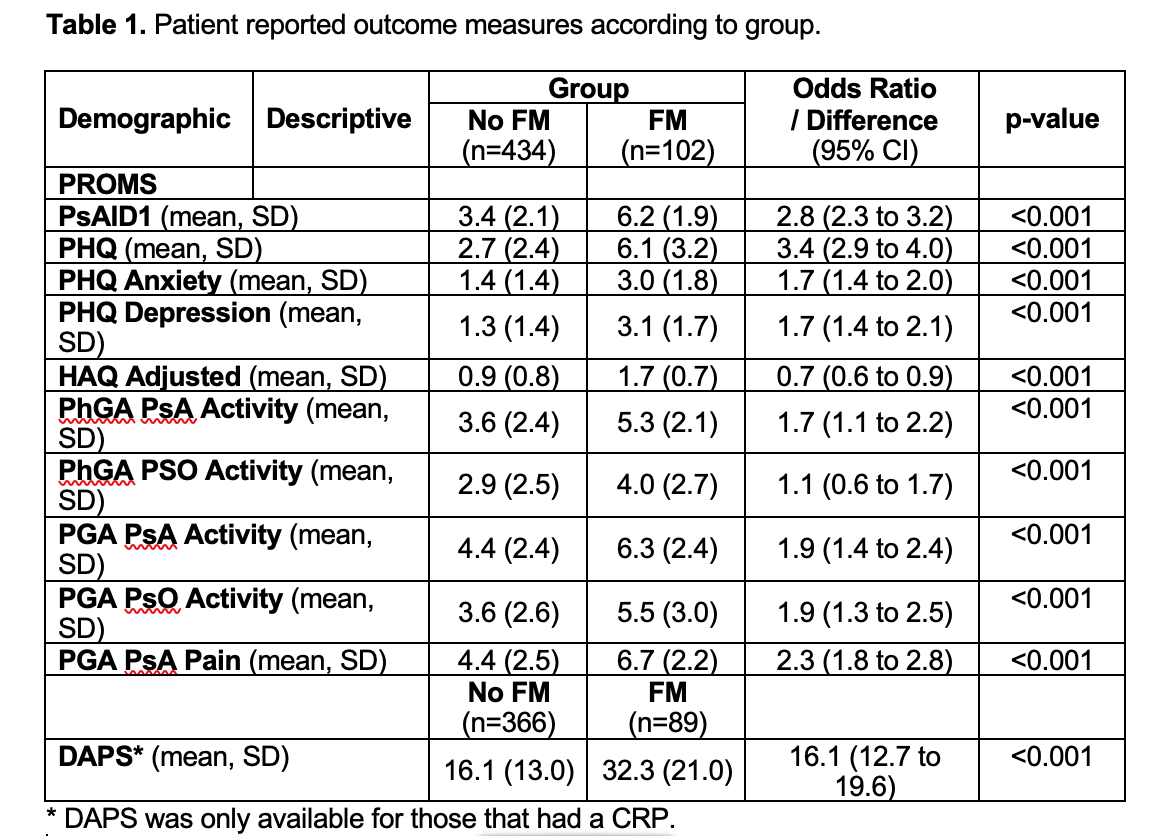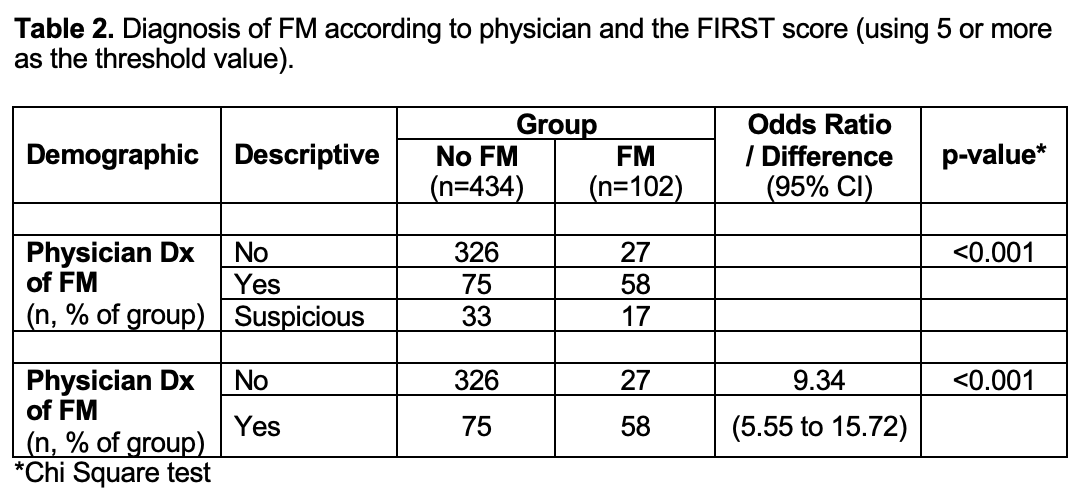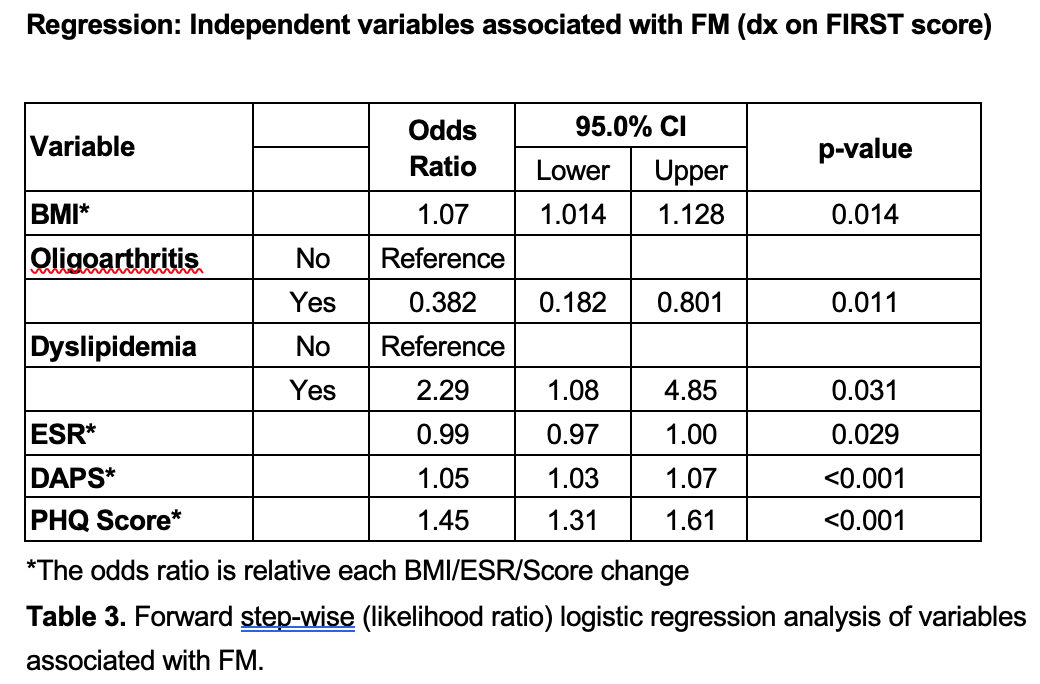Session Information
Session Type: Poster Session B
Session Time: 10:30AM-12:30PM
Background/Purpose: Fibromyalgia (FM), a chronic pain disorder, is more prevalent in psoriatic arthritis (PsA) patients, impacting quality of life and potentially leading to unnecessary treatment escalation. Cultural factors may influence FM presentation in Arab countries, necessitating an understanding of its frequency and impact in this region for effective interventions.
This study aims to determine FM frequency in Arab PsA patients using the FiRST questionnaire, identify associated factors, assess diagnostic agreement, and examine the impact of FM on patient-reported outcomes and disease activity, ultimately contributing to the development of culturally sensitive interventions.
Methods: Data from 554 PsA patients from the Arab League of Associations for Rheumatology (ArLAR) countries were analyzed. The primary outcome was the frequency of FM, determined using the Fibromyalgia Rapid Screening Tool (FiRST) questionnaire (score ≥6). Secondary outcomes included patient-reported outcomes (PROs) assessed using the Patient Health Questionnaire (PHQ),Health Assessment Questionnaire (HAQ), Physician Global Assessment (PhGA), Patient Global Assessment (PGA),Douleur Arthrite Psoriasis (DAPS), and Psoriatic Arthritis Impact of Disease (PsAID1) questionnaires. Independent predictors of a positive FiRST score were identified using logistic regression. The agreement between self-reported FM (FiRST) and physician-diagnosed FM (ACR 2010 criteria) was assessed using Cronbach’s Alpha.
Results: Of the 536 patients (mean age 45.6 years, 40.9% male), 19.0% (n=102) screened positive for FM. Independent factors associated with a positive FiRST score included a higher BMI (Odds ratio [OR] 1.07, p=0.014), not having oligoarthritis (OR 0.38, p=0.011), dyslipidemia (OR 2.29, p=0.031), a lower ESR (OR 0.99, p=0.029), and worse DAPS (OR 1.05, p< 0.001) or PHQ (OR 1.45, < 0.001) scores. Patients with FM reported significantly (p< 0.001) worse outcomes on PsAID1, PHQ, HAQ, PhGA, PGA and DAPS (for those with a CRP available). Agreement between self-reported using the FiRST questionnaire and physician-diagnosed FM was moderate with Cronbach’s alpha average measures intraclass correlation of 0.588 (95% CI 0.508 to 0.655). However, the FiRST score demonstrated good discriminatory ability for physician-diagnosed FM (AUC 83.3%, 95%CI 79.3 to 87.3%) with a threshold value of 3 offered 80% sensitivity and specificity.
Conclusion: FM was prevalent in Arab PsA patients, with one in five having a diagnosis of FM using the FiRST score and was associated with worse disease activity and quality of life. Discrepancies in diagnosis highlight the need for standardized approaches, potentially incorporating validated screening tools like FiRST, and increased awareness of FM in this population.
To cite this abstract in AMA style:
maroof a, Ziade N, El Kibbi L, Elzorkany B, Ani N, RIDHA A, Gorial F, AWADH N, Al Chama N, Haouichat C, Alnaimat F, Hannawi S, Hannawi S, Atawnah S, HALABI H, Al-Mashaleh M, Abogamal A, Bahiri R, Saad S, sabkar m, Aouad K, Gossec L, Hmamouchi I, abbas n, Bouajina E, Aljazye L, ayoub L. Frequency of Fibromyalgia Using Validated Measures in a Sample of Patients with Psoriatic Arthritis and Impact on Disease: A Cross-Sectional Multinational Study [abstract]. Arthritis Rheumatol. 2024; 76 (suppl 9). https://acrabstracts.org/abstract/frequency-of-fibromyalgia-using-validated-measures-in-a-sample-of-patients-with-psoriatic-arthritis-and-impact-on-disease-a-cross-sectional-multinational-study/. Accessed .« Back to ACR Convergence 2024
ACR Meeting Abstracts - https://acrabstracts.org/abstract/frequency-of-fibromyalgia-using-validated-measures-in-a-sample-of-patients-with-psoriatic-arthritis-and-impact-on-disease-a-cross-sectional-multinational-study/



